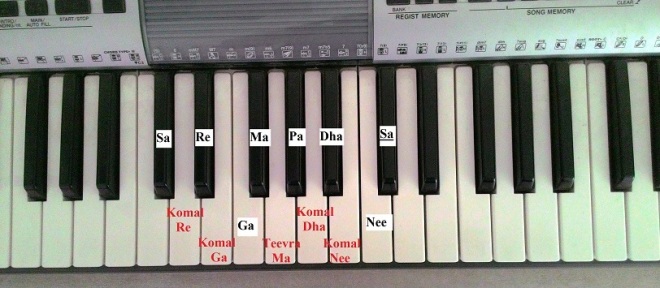Hello everyone!
In the previous blog post, I told you how the notes are named using Western notation. I also mentioned that the Indian scheme of notation is position-specific. So, here is what it means:
There are 7 notes in Indian system, and most of you must be familiar with them.
Sa, Re, Ga, Ma, Pa, Dha, Nee
Each of these has a name, e.g. Pa is Pancham, Ga is Gandaar etc. Generally, the shorter versions are used. These are the ‘shudhha’ (or pure) notes.
In addition to these 7 notes, there are 5 more notes, which are
Komal ‘Re’, Komal ‘Ga’, Teevra ‘Ma’, Komal ‘Dha’ and Komal ‘Nee’
The first note, Sa, changes according to the voice of the singer, and this what makes it position specific. Unlike Western notation, where a ‘D’ or an ‘F’ corresponds to a fixed note, the ‘Sa’ changes its position with respect to the singer.
Generally, the first black note (Kali Ek or C#) is the Sa of male voice and the 4th black note (Kali Chaar or Ab) is the Sa of female voice.
Given that the first note is ‘Sa’, the rest of the notes follow a particular order, as below:
Sa, Komal Re, Re, Komal Ga,Ga, Ma, Teevra Ma,Pa, Komal Dha, Dha, Komal Nee, Nee
So, for me (male voice), ‘Sa’ will be C#. And rest of the notes will follow the order. This is shown below:

The next note after ‘Nee’ will again be ‘Sa’, but with higher frequency (to be more specific, double the frequency of ‘Sa’ from which we started). So, this was for the male voice, and our ‘Sa’ was C#.
In this way, we can begin with any note on keyboard as our ‘Sa’ and the rest will follow the order mentioned above. You can try this out for Ab.
We’ll move on to the concept of scale in the next blog post.
(A thing to remember: The notes Sa and Pa are always shudhha, so no variants for these two.)
Nicely compiled , well explained.
LikeLike
Thanks Madhavi.
LikeLike